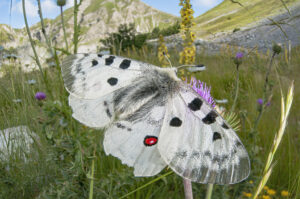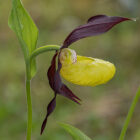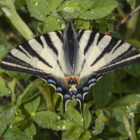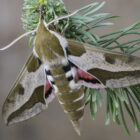Dates & Prices |
BOOK NOW |
Dates: 21st – 28th June 2025 Confirmed departure
Price: £1,795 Full
Single Room Supplement: £175
Deposit: £150 per person
Price Includes: All meals, accommodation with private facilities, ground transport, services of guides, holiday report
Not Included: Flights, travel insurance, drinks and any other personal items.
Leader: Paul Harcourt Davies & Lois Ferguson
Group Size: Minimum of 4 and a maximum of 7 guests plus 2 leaders.
Grade: Gentle paced walks in a variety of terrains. Ideally suited to photography.
Holiday Highlights
- Enjoy a wealth of wildflowers, butterflies, birds, and more among the spectacular scenery of the Italian Dolomites
- Exclusive high quality tour with a very small group specifically designed to increase each participants enjoyment of the holiday and to minimise the impact on the local sensitive environments where we visit
- Led by an elite team of Paul Harcourt Davies and Lois Ferguson, residents & citizens in Italy for 20+ years
- 1 centre tour for a leisurely and relaxing holiday
- Short drives for maximum time in the field
- Evening presentations on photography & environmental topics
- Possible to travel by train from the UK & why not extend your holiday with a stay in Venice too
Enjoy a week of leisurely wildlife watching in the dramatic & beautiful surroundings of the Italian Dolomites!

Paul Harcourt Davies is a professional photographer/author and conservationist with an international reputation gained through his images, his numerous books (19 to date), articles and lectures. He has led botanical, natural history and photographic trips for three decades and has lectured in the UK, USA, Cyprus (where he lived from 1978-81) and Italy on various aspects of photography and natural history, taught hundreds of workshops and is a prolific writer.
He is regarded as an authority on the Mediterranean flora and fauna (orchids in particular) and has been involved in numerous conservation projects. He was a founder member of the Hardy Orchid society, served as its chairman and is now an honorary Vice President: he was also chairman of Butterfly Conservation, S Wales. Paul has lived in Italy since 2003, where he is involved with numerous projects locally and nationally.
The soaring pinnacles of the craggy mountains of the Dolomites that look pink at sunrise and sunset tend to inspire everyone. Over the years, we have explored the region from the western to the eastern end settling upon Campitello in the Val di Fassa. A small town that allows access to a wide range of species rich habitats from riverside meadows and ancient woodland to sub-alpine and alpine meadows with accessible stony screes where the true alpines (gentians, androsaces, saxifrages and many other species) thrive. There is a tremendous variety of plants and a whole host of colourful butterflies when the sun comes out with one of the real treasures of this area being the Apollo butterfly and several fritillaries with a host of ‘blues’ and our tour is designed to produce a feast of interest for those who have both specialist interests but also a love of the natural world in general. There is nowhere better for photography from Landscapes through to macro work and leader Paul HD is internationally known for the breadth of his photographic work and as a gifted teacher ready to share. The ancient local pinewoods in the Dolomites. have a rich ground flora with orchid species such as Lady slipper, Coralroot, Bird’s nest and others, as well as a wintergreens (Pyrola sp) family. The sub-alpine and alpine meadows are extremely rich in a wide and colourful variety of wild flowers before they are traditionally cut for hay. Both Martagon and orange lilies are abundant plus a whole host of colourful plants including orchids such as the small white orchid, two species of fragrant orchid, glove orchids, vanilla orchids, elderflower orchids and several confusing species of marsh orchid (Dactylorhiza)… The true alpine zone lies above the tree line and is the one that is a delight for what, at first glance appears to be bare ground, is suddenly studded with a host of delightful plants when you stop and look closely. Life in this zone is hard for plants and animals alike and there is a degree of freneticism evident within a narrow window of opportunity in which to grow, to flower, to attract pollinators and then produce seeds…all between the melting of the snows in spring and the coming of snows in late autumn. Seasons can be unpredictable and depend on the melting of the snows in spring when the flowering succession begins For the photographer, alpine plants are one of the most delightful of all subjects for they are often low in stature (forming rounded clumps for protection) and have flowers that a large compared with the size of the plant. These flowers have to act as beacons for various insects that are on the wing and there are surprising numbers of butterflies and bees that act as pollinators. Here you will have a wonderful opportunity to capture mountain flowers set in spectacular scenery and Paul, a pioneer of wide angle close-up work can show you how this can be done to give that ‘wow’ factor. Our base, reached after travelling for 2.5 to 3 hours from Venice will be near Campitello in the Val di Fassa. It is a stunning area of mountain woodlands and high Dolomitic peaks with lots of walks in the surrounding countryside. We also have the opportunity of visiting high ground via the various cabin lifts that are operational. These will take us up to some incredibly species-rich areas with breathtaking scenery. We use passes for the lifts in the Val di Fassa that are included in the cost of the holiday. The area is mostly comprised of Dolomitic limestone – a carbonate of both magnesium and calcium, which was formed at the bottom of ancient warm seas ( it is astonishing to find marine fossils such as ammonites up at 3000m altitude). Close to where we stay, lie places where earth movements have pushed up far more ancient rocks through the dolomitic limestone. This produces a completely different flora for the volcanic rocks tend to be slightly acidic and they favour the growth of several species of colourful, dwarf primulas, for example If this season is reasonably early then the first few flowers of a real Alpine treasure – the king of the Alps (Eritrichium nanum) – might be found…we shall try. We are close to the Sella Region which has a number of famous passes and a legendary flora – The alpine plants include numerous saxifrages, Pasque flowers, gentians and three species of Soldanellas, the delightful ‘snow bells’. With gentle walking we can head to where there are patches of snow or where the snow has recently melted and find an abundance of spring crocuses and many other flowers that form part of the progression as spring advances. Flexibility: We appreciate the capriciousness of nature (orchids in particular) when conditions can change from one year to the next. Meadows can be cut for hay, for example, and there are never the same species two years in succession. We respect the fact that people who travel with us demand something special and that, we try our best to deliver by having a wide range of alternative sites to visit. Accommodation: We stay in Campitello di Fassa, in a comfortable family-run hotel with access to both dolomitic and granite mountains via the network of cable cars that function in the summer months. All rooms have private en suite bathrooms. There is a great variety of habitats in the area…ancient pine and beech woodlands, riversides, alpine meadows and high screes. Food & Drink: For those who are lovers of Italian cuisine the Dolomites (Trento region) has a strong Austrian influence through its history as part of the Austro-Hungarian empire. It is good and wholesome… polenta features highly along with pasta and the cakes are wonderful… ideal mountain fare. In the hotel we use the food is first rate and varied and we also sample the local restaurants on one or two nights for variety. There are also some interesting wines, particularly the whites that originate in the Trento and Veneto regions on the southern borders of these mountains. Practicalities: The Dolomite paths are excellent and clearly way-marked but there are occasional parts some might find vertiginous, whereas others will delight in the view. Our trips are gentle and be assured that we avoid anything with steel ropes and iron ladders…the legendary Via ferrat! However, if you are at all concerned about degree of difficulty then please talk to us. We will work to make sure that you see the best of the flowers wherever we can. • Whereas daytime temperatures can be very pleasant we are often at high altitude and so lightweight extra layers are advisable as part of your luggage. This is a small group holiday with 6 participants. We recommend booking soon to guarantee a place!
• In every mountain region paths are stony: light boots will suffice but good ankle support is essential. Most important is that you feel comfortable. 





The days marked in red are days with trips on the cable cars to high places. The order will change according to local weather…mornings can often be bright but cloud builds up only to clear by early evening.
Day 1: After flying to Venice we meet you at the airport and transfer you to our hotel in Campitello di Fassa:
Day 2: Campitello to Canazei (walk)
A track accessible just a short distance outside Campitello on the road to Pian leads to Canazei through woodlands and open meadows which are often very flowery…orchids etc. We drop down to the valley and walk back along the river through woodlands where Lady’s Slipper grows along with a host of interesting plant species.
We take the road that leads to the Gardena pass where we find numerous orchids including the Globe orchid (Traunsteinera globosa).
Day 3: Col Rodela (L)
The cable car lies within easy walking distance of our hotel and takes one to the Col Rodela. It is an extensive area of rolling alps with impressive mountain views. Plants depend on season but include Androsace (rock jasmine) globe flower, several species of snowbells (Soldanella…). There is a refuge close to the cable car and then one higher up…the slopes leading to it are rich in alpine flowers
Riverside walk south of Campitello …The path leads through woods with a mossy floor with a rich flora…several species of wintergreens, for example. Several places for Lady’s Slipper
Day 4: Campitello – Pian
A traditional village, Pian, lies above Campitello and is something rare in the Dolomites where development for ski tourism has seen so many old places destroyed. There are flower-filled meadows around Pian and the road beyond leads into the Val Duron, a rich area for alpine flowers
Day 5:Alba di Canazei – Ciampac (L) to high ridge
A cable car allows access to a remarkable area where there is the expected rich dolomitic flora plus outcrops of acidic rocks that introduce a completely range of plants.
Alba di Canazei – Cold di Rosso
This involves taking the chairlift on the opposite side of the valley to Ciampac.
Day 6: Passo Pordoi and Val Gardena
A journey through some staggering scenery takes us to the Pordois pass and Sella massif. There are many good places or wild flowers in the area both close to the pass and high above….
One of the famous passes that makes the ring around the Sella so beloved of motorcyclists. The Pordoi has an extensive area of rocky outcrops which are very rich in all sorts of species of alpine flowers…violets, clematis, soldanellas..orchids. We take a different route back to the hotel that takes in part of the Val Gardena with wonderful flower meadows.
Day 7: Marmolada and surrounding area (L).
The road beyond Alba takes us to the Lago di Fedaia where there is a track to some rich alpine meadows. Beyond lies a cable car to the heights of the Marmolada…though in some years the cable journey is not worthwhile since the snows have not receded sufficiently…we shall see.
Afternoon Riverside walk south of Campitello
To Fontanazo and beyond. Transfer to Moena to explore the riverside woods and meadows there.
Day 8: Return home via flights from Venice.
NB Weather can be unpredictable in any high mountain region and the Dolomites are no exception. We often chop and change days to make sure that you see as much as possible. In some years seasons are early and some meadows might already be cut accordingly..
Day 8: Transfer back to airport in Venice for departure.
To follow later
To follow later








































































